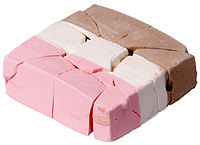
Photo from wikipedia
Abstract Phenolic compounds constitute important parts of natural bioactive ingredients due to their various biological activities. However, phenolic compounds are to some extent restricted by low solubility, poor stability, unpleasant… Click to show full abstract
Abstract Phenolic compounds constitute important parts of natural bioactive ingredients due to their various biological activities. However, phenolic compounds are to some extent restricted by low solubility, poor stability, unpleasant taste and low bioavailability. Spray-drying microencapsulation is an effective strategy to ameliorate or even tackle such problems and it is crucial to choose optimal wall materials which may affect functional properties of the encapsulated components. In this review, we first described and discussed the physicochemical characteristics of commonly used wall materials for spray drying. Then we summarized the work done in past 16 years about the microencapsulation of phenolic compounds including anthocyanidin, curcumin, catechins, gallic acid, and resveratrol using spray drying is reviewed with a focus on the role of wall materials. Furthermore, we propose some targeted encapsulation strategies for different bioactive ingredients to explore their applications. Finally, we intend to encourage more research in rational selection of the wall materials.
Journal Title: Powder Technology
Year Published: 2021
Link to full text (if available)
Share on Social Media: Sign Up to like & get
recommendations!